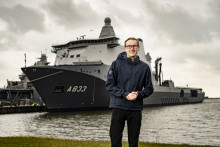‘You walk past the frigates, surrounded by military personnel in uniform. It is fascinating to watch them try to make the world a slightly better place. Still, I do spend most of my time in an office,’ says the PhD candidate of Engineering Technology's Dynamics Based Maintenance department.
With his research project, Keizers contributes to the Royal Navy's PrimaVera project, which stands for ‘Predictive maintenance for Very effective asset management.’ As part of this project, the UT collaborates with various other educational institutions, businesses and organisations on predictive maintenance. ‘I think many businesses and organisations still view maintenance like a bothersome cost item,’ he says. ‘Things breaking down is simply a fact of life. However, maintenance is often conducted either way in advance or only after something has already broken down. That leads to higher costs. Meanwhile, businesses prefer to spend their money on developing an amazing new concept, for example, rather than a new maintenance strategy. However, investing in proper maintenance can actually help you save so much money in the long run that you have even more to spend on the development of those new concepts.’
Those savings are mainly realised through maintenance that is conducted at exactly the right moment. This is also known as just-in-time maintenance. ‘Methods designed to realise that situation are usually based on either data or physics,’ he explains. However, Keizers knows that both approaches have their shortcomings. ‘Physical models are plagued by uncertainties. They are based on tests conducted in a laboratory environment. Even with constant environmental factors, there are variations in the degradation profiles of such components. When conducting a laboratory test, you also know exactly what kind of strain you are subjecting your material to. Real life is never that controlled, which is certainly true for naval ships.’
The data-driven methods present a different challenge. ‘What it comes down to is gathering a wealth of data and using those to identify trends and predict when something will break down. The major problem is that there is simply a lack of data on component breakdowns. The whole point is that you want to conduct timely maintenance on the most critical components - for which accurate predictions would be most profitable - because a breakdown is costly or catastrophic,’ Keizers explains.
In his research, he therefore combines the physics with the data. ‘I use a physical model as the basis for an algorithm, which I try to make increasingly effective and more accurate with the help of data. The goal is to allow the algorithm to learn as it goes,’ Keizers continues. When circumstances change, that increases the stakes. Not all waters are calm and not all exercises are as intense as others. ‘You can extrapolate a current data trend to the future, but if your current usage profile is not representative, you will end up with an inaccurate prediction,’ Keizers says. All the more reason for him to leave the laboratory from time to time. ‘I hope to build a bridge between the largely theoretical world of academia and the practical concerns of the industry.’
The doctoral candidate knows that this will be no mean feat. Data alone will not be enough. ‘Entrepreneur and best-selling author Chris Anderson once wrote that data will make the theoretical sciences superfluous. For me, it is more about bringing the two worlds together. I believe there are myriad benefits to combining physics with data. The physics can shed more light onto why a data trend looks the way it does.’







